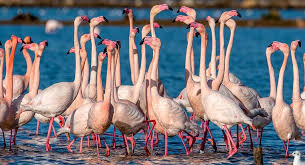Portugal’s first nature reserve was once used as a rubbish dump – now it’s a sanctuary for flamingos

Lisbon: What is now one of Portugal’s most ecologically significant sites – home to over 200 bird species, including flamingos – was once used as a dumping ground.
Celebrating 50 years since its new status, the Sapal de Castro Marim and Vila Real de Santo António Nature Reserve, located at the mouth of the Guadiana River in the eastern Algarve, once had little to suggest its future as a model for environmental protection. Created on paper in 1975, the reserve didn’t see its first nature wardens until 1988. One of them, Paulo Monteiro, is still on the job.
Speaking to Lusa news agency, Monteiro recalled a time when most didn’t even bat an eye when dumping rubbish in the area, even local authorities. Times have changed, thankfully, and “today, local authorities also look at nature conservation in a completely different way. We have mayors who see nature conservation as an asset, as added value. And this is clearly important for the enhancement of the protected area.”
Indeed, what was once a neglected stretch of salt marshes and brackish lagoons is today a thriving habitat, visited by thousands of nature lovers each year. The change, according to Monteiro, didn’t come easy. Hunters and landowners initially saw the designation as a barrier to development. Over time, attitudes shifted.
The reserve spans 2,300 hectares and supports traditional salt production alongside its conservation efforts. The establishment of the reserve also prompted salt workers to form a cooperative, boosting organisation and economic sustainability in the area.
Rosa Madeira, another long-serving staff member, has spent nearly four decades raising awareness about the reserve’s role. As she told Lusa, it is thanks to the creation of the reserve that people are able to visit this natural haven today, with most travelling to the reserve to see flamingos.
In 2020, flamingos nested in Portugal for the first time at the reserve. The event hasn’t repeated, but ICNF (national forest and nature conservation institute) experts are investigating ways to encourage nesting again.
“It was also an atypical year (due to the Covid-19 pandemic) when nature tourism was restricted and the area where they nested became much quieter because they are birds that nest in colonies,” she explained.
According to Rosa Madeira, the flamingos “have made a few more attempts” at nesting in the area, but to no avail.
Meanwhile, across the border in Spain, Doñana National Park, one of Europe’s most iconic wetlands, has been suffering under prolonged drought. The situation has led Spanish nature tourism companies to look toward Castro Marim as a promising alternative.
“There are nature tourism companies that are currently coming to Portugal because Doñana has had a very turbulent period, and companies have started to invest in nature tourism here in the reserve area because it is closer,” she said.
The nature reserve is currently managed by a co-management committee composed of the mayors of Castro Marim and Vila Real de Santo António, the regional director of Nature Conservation and Forests of the Algarve and representatives of the University of the Algarve, non-governmental environmental organisations and local associations.
The classification of the Castro Marim reserve didn’t just clean up a local wetland – it sparked a nationwide conservation effort. Portugal now boasts nine official nature reserves, covering fragile ecosystems from estuaries to wetlands and salt marshes.
According to João Alves, a biologist with over 40 years of experience from the ICNF, the protected status helped shield key areas from industrial damage, pollution, and uncontrolled development. “The balance is clearly positive, since if these areas of the territory – as well as others that had a different classification (such as Natural Park) – had not been classified and protected, they would certainly have been very much altered and certainly for the worse,” he said.
Other reserves followed over time: the Tagus Estuary (1976), São Jacinto and the Berlengas (1980s), Serra da Malcata (1981) – home of the endangered Iberian lynx – Paul de Arzila (1988) and Lagoas de Santo André and Sancha (2000).
These areas now benefit from targeted zoning, land-use regulation, and ecosystem protection strategies. In the case of the Tagus Estuary, dolphin sightings have returned after pollution controls were introduced.
Alves credits the reserves not only with ecological recovery but also with raising environmental awareness among municipalities.





